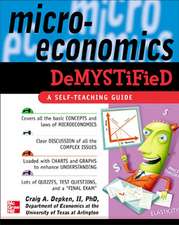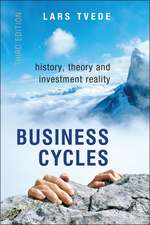Employment without Inflation
Autor Benjamin Higginsen Limba Engleză Hardback – 31 mai 1996
Preț: 772.07 lei
Preț vechi: 1107.40 lei
-30% Nou
Puncte Express: 1158
Preț estimativ în valută:
147.73€ • 154.26$ • 121.99£
147.73€ • 154.26$ • 121.99£
Carte tipărită la comandă
Livrare economică 16-30 aprilie
Preluare comenzi: 021 569.72.76
Specificații
ISBN-13: 9781560002598
ISBN-10: 156000259X
Pagini: 394
Dimensiuni: 152 x 229 x 36 mm
Greutate: 0.89 kg
Ediția:1
Editura: Taylor & Francis
Colecția Routledge
Locul publicării:Oxford, United Kingdom
ISBN-10: 156000259X
Pagini: 394
Dimensiuni: 152 x 229 x 36 mm
Greutate: 0.89 kg
Ediția:1
Editura: Taylor & Francis
Colecția Routledge
Locul publicării:Oxford, United Kingdom
Cuprins
Preface
Part I: Introduction
1. From "Business Cycles" to Shifting Trade-Off Curves and Loops
Part II: Business Cycles and Theories to Explain Them:1825–1960
2. Unemployment or Inflation: Experience, Theory, and Policy 1825–1960
3. Underemployment Equilibrium, Secular Stagnation,and the "Knife Edge"
4. Interactions of Cycles and Trends
Part III: Postwar Economic Fluctuations as Shifting Trade-Off Curves and Loops
5. Concepts and Definitions
6. Unemployment and Inflation in Canada
7. Unemployment and Inflation in Australia
8. Unemployment and Inflation in the United States
9. Canada, Australia, and the United States:Similarities and Differences
10. The New Long-Term Unemployment
Part IV: Unemployment and Inflation since 1950:Hypotheses, Theories, Explanations
11. Unemployment and Inflation since 1950: Hypotheses and Theories
12. The Machine, the Structure, and the Game
Part V: Policy
13. The Approach to Policy
14. Designing Policy for the Late 1990s and Beyond
15. Why Not Full Employment?
16. Conclusions and Summary
Index
Part I: Introduction
1. From "Business Cycles" to Shifting Trade-Off Curves and Loops
Part II: Business Cycles and Theories to Explain Them:1825–1960
2. Unemployment or Inflation: Experience, Theory, and Policy 1825–1960
3. Underemployment Equilibrium, Secular Stagnation,and the "Knife Edge"
4. Interactions of Cycles and Trends
Part III: Postwar Economic Fluctuations as Shifting Trade-Off Curves and Loops
5. Concepts and Definitions
6. Unemployment and Inflation in Canada
7. Unemployment and Inflation in Australia
8. Unemployment and Inflation in the United States
9. Canada, Australia, and the United States:Similarities and Differences
10. The New Long-Term Unemployment
Part IV: Unemployment and Inflation since 1950:Hypotheses, Theories, Explanations
11. Unemployment and Inflation since 1950: Hypotheses and Theories
12. The Machine, the Structure, and the Game
Part V: Policy
13. The Approach to Policy
14. Designing Policy for the Late 1990s and Beyond
15. Why Not Full Employment?
16. Conclusions and Summary
Index
Descriere
The world economy has undergone a fundamental transformation in recent decades and theoretical structures inherited from the 1930s through the 1950s, while retaining large elements of truth, are inadequate to deal with current problems












